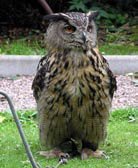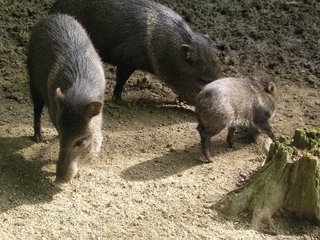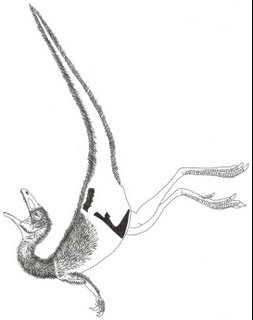British eagle owls: an update

Yesterday I visited Bernie to compare dead stag beetles (go here for more on this) and to collect both my dead Fire salamander Salamandra salamandra, and an assortment of old stuffed birds (all of which are needed for a project on foot claw morphology: more on that in the future). While at his house I noticed that the February edition of Bird Watching magazine – which I often look at in the shops but never buy – includes an article by Adrian Thomas on Eagle owls Bubo bubo in Britain. The cover states ‘What is Europe’s top hunter doing in the UK?’. An article on British eagle owls has also recently appeared in The Palaeontological Association Newsletter (McGowan 2006) and several web sites, including those of the RSPB and World Owl Trust (WOT), have also provided new, updated information on this subject within recent months. In a previous post I introduced this subject, and because new information is now available, it’s an appropriate time for an update.
In the previous post I noted how a recent BBC TV programme (which I now learn was titled Return of the Eagle Owl) made the incredible claim that there might be as many as 500 pairs abroad in this country. Unfortunately I missed the relevant programme, and this claim came to me as a pers. comm. from someone who saw it. Well, here’s a good demonstration of why you shouldn’t necessarily trust pers. comms. Read on.
The best known British eagle owls are a pair in the Yorkshire Dales that successfully bred on Ministry of Defence land in the spring of 2005. They’ve actually been breeding since 1997, or possibly 1996, and have managed to raise 23 chicks during this time. Thomas (2006) mentioned ‘two other confirmed breeding pairs in the UK’ (p. 13) and noted that there are possibly more, and it has also been brought to attention that pairs in Galloway, Invernesshire and Sutherland have also been confirmed as breeders. It’s unlikely that the ‘500 pairs’ is anywhere near likely therefore, nor was this figure mentioned in Return of the Eagle Owl, so don’t take it seriously!
Already some of the chicks of the Yorkshire pair have moved far afield, with one of them having been reported from Shropshire (where it was electrocuted on power lines). As Tommy Tyrberg noted in a comment on the previous post, eagle owls aren’t really birds of ‘surviving vestiges of wilderness, immune from human exploitation’ as it says in Birds of the Western Palearctic, but are actually quite happy living close to people. Populations in The Netherlands and Sweden are doing ok close to noisy quarries, in working farmland, and in and around rubbish dumps. Britain is a small place with no wilderness at all, and evidence for humans and their recent activity is everywhere, so the adaptability of the eagle owl, and its success on the continent despite human activity, certainly suggests that it’ll do fine in this country.
Having said that, in January 2006 came the disappointing news that the female of the Yorkshire pair had been killed, with its death apparently occurring just before Christmas. Autopsy showed that the shot used was large-gauge like that used to shoot foxes, and not small-gauge like that used for hunting gamebirds (thus probably ruling out a case of mistaken identity). The bird had an empty stomach, and thus may have starved to death after being shot. If eagle owls are colonising our islands naturally, this is a sad loss of an important individual. The killing may also have been illegal – ultimately this depends on whether or not the bird was here ‘naturally’ – and the North Yorkshire Police are pursuing enquiries.
Thomas (2006) also provided some new discussion on the source of origin of the British eagle owls: might they be vagrants that are naturally colonising Britain from continental Europe? He noted two pieces of evidence that might support this hypothesis. Firstly, Return of the Eagle Owl looked at the research of raptor conservationist Roy Dennis, and his examination of 18th and 19th century eagle owl records in Britain shows that the birds were mostly reported between September and January – the time ‘when one might expect vagrants to arrive’ (Thomas 2006, p. 15).
Secondly, ornithologists monitoring eagle owls in Switzerland have shown that the birds can move as far as 350 km, passing obstacles such as major mountain ranges as they go. A hop across the English Channel may therefore seem no trouble at all, and indeed we know that some European owls, like Long-eared owls Asio otus and Short-eared owls A. flammeus, cross bodies of water like the North Sea regularly.
Thomas (2006) countered that sedentary European birds seem to find the English Channel and/or the North Sea an insurmountable barrier: Black woodpeckers Dryocopus martius don’t cross the channel for example, even though their range approaches the French coastline. Similarly, Eurasian pygmy owls Glaucidium passerinum – widespread in Scandivania where they range right up to the North Sea coastline – have never colonised Britain. Ural owls Strix uralensis and Great grey owls S. nebulosa are widespread in Sweden, but also haven’t colonised Britain. Tawny owls S. aluco don’t cross the Irish Sea. However, just because these species are sedentary doesn’t mean that eagle owls have to be too. As the Long-eared and Short-eared owls show, rules on dispersal capability vary among species and there isn’t a single rule that applies to all Strigidae. The possibility that British eagle owls are natural colonisers is therefore worthy of consideration and needs more investigation.
Tony Warburton of the World Owl Trust has written a piece (go here) on the WOT’s position. They are confident that the British eagle owls are natural colonisers, and that confirmation of eagle owl breeding in Britain is news akin to that of the reintroduction of the White-tailed eagle Haliaeetus albicilla or the successful increase in Red kite Milvus milvus numbers. The WOT also contends that the British Ornithologists Union should now add Eurasian eagle owl to the official British bird list and that they should receive full protection.
What does the BOU say about this? In a 1996 review of the eagle owl’s status in Britain, they concluded that insufficient evidence was available to accept the species on the British list (they concluded that the 90 reports they examined were either not definitely of Bubo bubo, or might have been of birds that had escaped from captivity). So far as I can tell, they are watching the situation but are not yet prepared to be as positive as the WOT is about possible native status. Similarly, the RSPB is being cautious: they say that they would be more than happy to accept the species as a native, but compelling evidence that demonstrates this has yet to be produced (go here for their statement).
We have some more news on fossils. I noted in the previous post that Giles (2006) drew attention to John Stewart’s mention of possible post-glacial eagle owl fossils. In The Palaeontological Association Newsletter article mentioned above, Al McGowan (2006) also mentioned Stewart’s interest in this subject and, even better, discussed and figured an eagle owl carpometacarpus from post-glacial deposits near Cheddar, Somerset. This provides powerful support for the natural presence of the species in modern Britain (‘modern’ in the geological sense you understand). You can see McGowan’s article here.
Of course, if our eagle owls have gotten here naturally, they would be protected under the Wildlife and Countryside Act. Any impact that they have on other British animals – and as discussed in the previous post they might affect raptor numbers as well as those of Black grouse Tetrao tetrix – will be something we can record, but not intervene in. Conversely, if it can be shown that the British eagle owls were bred in captivity and later released, they don’t deserve protection and an argument could be made that they should be removed.
Given the balance of evidence, my feeling at the moment is that at least some of our eagles owls have gotten here themselves. We await further news.
The photo above is from The Palaeontological Association website and was taken at the Combe Martin Wildlife and Dinosaur Park (Devon) by Adrian Pingstone.
For more on owls (focusing on their asymmetrical ears) go here.
Refs - -
Giles, J. 2006. Bird lovers keep sharp eye on owls. Nature 439, 127.
McGowan, A. 2006. Should eagle owls be considered native to the UK? The Palaeontological Association Newsletter 61, 21-23.
Thomas, A. 2006. Where eagles dare. Bird Watching Feb’ 2006, 12-18.
























